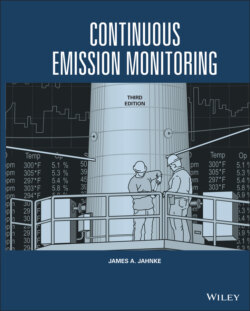Читать книгу Continuous Emission Monitoring - James A. Jahnke - Страница 12
A BRIEF HISTORY
ОглавлениеAttempts were made in the 1960s to use ambient air analyzers and process industry analyzers to measure source emissions. Ambient air analyzers were not successful at that time due to the instability of dilution systems. However, process analyzers did prove to be useful, particularly those that employed ultraviolet and infrared photometric techniques. Then, in the late 1960s and early 1970s, successful developments emerged in instrumentation in Germany and the United States. Ambient analyzers were redesigned to measure gases at higher concentration levels, and the so‐called “in‐situ” analyzers were developed, which can measure gases in the stack without sample extraction. These methods, in addition to new German optical systems for opacity monitors and the development of luminescence measurement techniques in the United States, provided a technological base from which continuous emission monitoring (CEM) regulations could be established.
Continuous emission monitoring requirements in the United States were first promulgated in 1971. However, the CEM industry did not begin to develop until after 6 October 1975 when the U.S. Environmental Protection Agency (U.S. EPA) established performance specifications for CEM systems and required their installation in a limited number of sources. Since then, CEM systems have been applied to a wider range of sources, and over 50 years of experience has led to the evolution of analyzers and monitoring systems with ever‐improving performance The technology is considered mature, having a solid foundation in reliable instrumentation, procedures, and standards that can assure the quality of source emission data at specified limits of accuracy and precision.
The earliest focus of CEM technology was on the analyzer – the instrument that measures. However, it was soon found that the process of transporting the gas to the analyzer was a source of many problems. Such problems were addressed in a number of ways by CEM “systems” integrators. Those who understood the effects of corrosive stack gases on materials and the effects of pressure and temperature on gas transport were the first to design and successfully market systems that worked under severe sampling conditions.
The difficulties associated with extractive systems led to the idea of measuring the flue gases as they exist in the stack or duct, without conditioning. This idea was realized in the development of “in‐situ” analyzers, second‐generation source monitoring systems especially designed to avoid problems inherent in extracting gases. In‐situ systems have been designed to measure gas concentrations, flue gas opacity, flue gas flow, and particulate matter concentrations. Many present‐day CEM systems are a combination of extractive and in‐situ systems (Figure 1‐1).
Third‐generation systems emerged with the promulgation of the Clean Air Act Amendments of 1990 and the implementation of the acid rain allowance trading program. Requirements to report emissions in tons per year led to the demand for systems that could measure pollutant mass rate. As a result of this program, flow monitors and dilution‐extractive systems were added to the inventory of monitoring methods. It was in the acid rain program that CEM systems found their maturity. To assure the success of plant monitoring programs, both equipment and personnel resources were made available by corporate management. And here, it was found that for the success of monitoring programs, trained and experienced personnel can be equally important as the equipment.
A fourth wave of continuous emission monitoring applications came after 2000 with the delayed and piecemeal regulatory development of rules for hazardous air pollutants. The program to control hazardous air pollutant emissions was promulgated in the 1990 Clean Air Act Amendments along with the acid rain program; however, due to the enormity of the task of regulating 187 hazardous air pollutants from 174 source categories, the program was slow to start. It wasn’t until after 2000 that continuous monitoring requirements for air toxics began to come into effect, but the need to develop new and more sophisticated monitoring systems for measuring particulate matter, mercury, and hydrochloric acid was apparent before that time. A new generation of monitoring systems was developed, measuring a wider range of compounds and materials, at ever lower concentrations, by incorporating advanced measurement and miniaturization techniques developed in response to national military and security concerns.
The business of continuous emission monitoring is largely dependent upon environmental regulations and is almost cyclical with the ebb and flow of environmental rule‐making. As new regulatory programs are developed, it is found necessary that a means be provided to keep track of progress or lack of progress. When emission limits are mandated, enforcement programs require a measure of whether emission limits are met or not. Intermittent manual stack testing is clearly not adequate for this purpose, and it has been demonstrated that continuous emission monitoring systems can provide data of sufficient precision and accuracy to support enforcement programs and allowance trading programs. With emission limits becoming ever more stringent and the proper operation of pollution control equipment ever more critical, continuous emission monitoring systems have evolved where they can today, meet the most demanding applications.
Figure 1‐1 A continuous emission monitoring (CEM) system.
